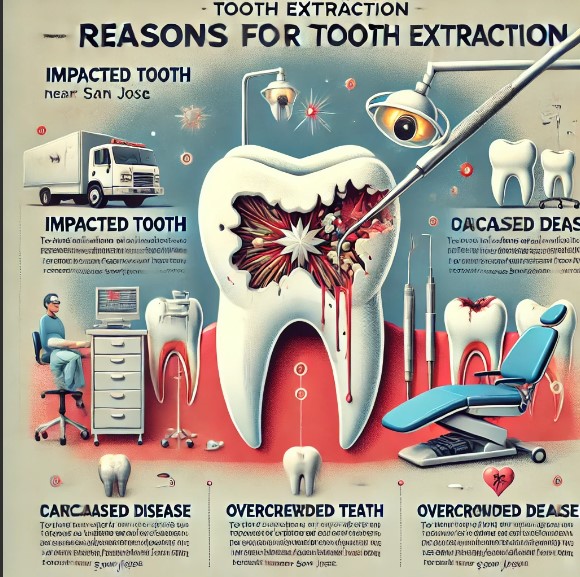Tooth extraction is sometimes necessary to protect and maintain your overall oral health. While the idea of having a tooth pulled may seem daunting, it can prevent more severe health issues and alleviate pain caused by problematic teeth. Here are five common reasons why a dentist to pull a tooth near San Jose might be needed: impaction, tooth decay, periodontal or gum disease, trauma, and overcrowding. Although preventive care like regular dental check-ups can help you avoid some of these conditions, others may require extraction to preserve your long-term oral health.
5 Top Reasons You Need An Extraction
1. Impaction
Tooth impaction occurs when a tooth doesn’t have enough space to emerge or grow properly, often pushing against other teeth. This condition is particularly common with wisdom teeth, the third set of molars that usually appear in late adolescence or early adulthood. Because these teeth often don’t have enough room to grow upright, they can become trapped under the gums or grow at an angle towards adjacent teeth.
Impacted teeth can cause various problems, including pain, swelling, and infection. You might notice symptoms such as red, swollen, or bleeding gums, as well as pain in your jaw or difficulty opening your mouth. If left untreated, impacted teeth can damage nearby teeth, leading to more serious oral health issues.
2. Tooth Decay
Tooth decay is one of the most common dental issues, caused by the accumulation of plaque and tartar on the teeth. Plaque is a sticky film of bacteria that forms on the teeth when sugars from food and drinks are not properly cleaned away. Over time, plaque hardens into tartar, which can erode the enamel and create cavities.
If tooth decay is not addressed early, it can lead to significant damage. The enamel becomes weak and brittle, and the decay can reach the inner layers of the tooth, causing infection. Symptoms of severe tooth decay include intense pain, swelling, and redness around the affected tooth.
3. Periodontal or Gum Disease
Periodontal disease, commonly known as gum disease, affects the gums and the bone structures that support the teeth. It begins as gingivitis, a mild form of gum disease characterized by inflammation, redness, and bleeding gums. If left untreated, gingivitis can progress to periodontitis, a more severe condition that can cause the gums to pull away from the teeth, creating pockets where bacteria can accumulate.
As periodontal disease advances, it can lead to the deterioration of the bone and connective tissues that hold the teeth in place. This can cause teeth to become loose, and in severe cases, tooth extraction may be necessary to prevent the infection from spreading further.
4. Trauma
Teeth are vulnerable to injury, especially during accidents or physical trauma. Whether it’s a sports-related injury, a car accident, or an unexpected fall, a strong impact can crack, chip, or completely knock out a tooth. In some cases, the damage to the tooth is so severe that it cannot be repaired with a crown or filling, making extraction the best option.
Trauma to a tooth can also affect the surounding structures, including the gums and jawbone. If a tooth is severely damaged but not removed, it could lead to further complications, such as infections or abscesses. An infected tooth might require more complex procedures like a root canal, which can be just as painful and costly as an extraction.
5. Overcrowding
Overcrowding occurs when there isn’t enough space in the mouth for all of the teeth to align properly. This can cause teeth to overlap, twist, or become misaligned, leading to bite issues and aesthetic concerns. Overcrowded teeth can also make it difficult to clean between them, increasing the risk of decay and gum disease.
To address overcrowding, your dentist or orthodontist may recommend extracting one or more teeth. Especially if the overcrowding is severe enough to cause discomfort or dental problems. This is often a common step in orthodontic treatment plans, where removing specific teeth creates. More space for the remaining teeth to shift into better alignment.
What to Expect During a Tooth Extraction
The thought of tooth extraction can be intimidating, but understanding the process can help ease your concerns. There are two main types of tooth extractions: simple and surgical.
In a simple extraction, the dentist numbs the area around the tooth with a local anesthetic and uses special tools to loosen and remove the tooth. This procedure is typically quick and straightforward, with minimal discomfort.
Surgical extractions are more complex and are usually necessary when a tooth is impacted or broken below the gum line. In these cases, the dentist or oral surgeon makes an incision in the gum to access the tooth. Sometimes removing bone or cutting the tooth into smaller pieces to make extraction easier. You may be given sedation or general anesthesia to keep you comfortable during the procedure.
Conclusion
Tooth extractions are sometimes necessary to protect your oral health and prevent more serious complications. Whether due to impaction, decay, gum disease, trauma, or overcrowding, removing a problematic tooth can alleviate pain, prevent infections, and improve your overall dental health. While the idea of losing a tooth might be daunting, modern. Dental techniques ensure that the procedure is as safe and comfortable as possible. Remember, your dentist to pull a tooth near San Jose will explore all other treatment options before recommending extraction, and when it is necessary, it’s a crucial step in maintaining a healthy, functional smile.






More Stories
Gabantin 100 mg vs. Other Seizure Medications: Which Works Best?
Cosmetic Surgery in Your 30s vs. 50s: What Changes?
Love Stories That Flourished in Old Age Homes